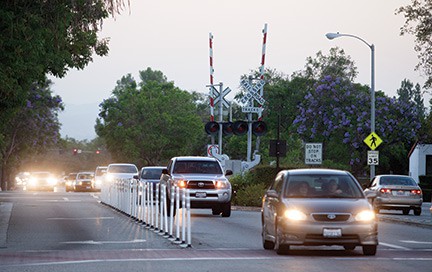Proposed Gold Line bridge grounded by city council 4-1

Heeding concerns from residents, the Claremont City Council is doing away with the proposed Gold Line bridge over Indian Hill Boulevard.
The council voted 4-1—with Councilmember Joe Lyons voting against—to keep the incoming light rail system at grade, or at street level. Mr. Lyons, in his dissenting vote, expressed concern about impending traffic woes that could pla
In his presentation to the council, City Manager Tony Ramos noted the decision to keep the rail at street level was borne from negative reactions by residents, who saw the proposed bridge as a dividing line between north and south Claremont and an ugly addition to the Village.
“Hearing our residents at the last meeting [who] were very concerned about that great divide,” Mr. Ramos said. “That was a very large concern that we took into consideration.”
Two alternative bridges were presented in the staff report—a “two-span” design concept with a larger opening over Indian Hill, and a “four-span” concept that was touted as an “open-air” design. The $28 million Metro had allotted for a possible bridge would cover the two-span option, but the four-span concept would cost an additional $5 to 6 million, which the city would have to pay.
“Unfortunately, we do not have that funding available to contribute to the construction of the four-span bridge design, due to the other obligations which we have,” Mr. Ramos said. “And I don’t foresee any grant opportunities available for this purpose.”
Mr. Ramos warned the council and residents in attendance that the Gold Line being built at-grade would create a “large inconvenience” to motorists who attempt to travel through a clogged Indian Hill Boulevard. According to the report, one light rail train is expected to cross Indian Hill every five minutes, with a gate-down time of around 45 seconds each time.
“I do want to go on record to make sure everyone here understands, there will be delays on Indian Hill,” Mr. Ramos said. “There will be more trains coming through there.”
The vote comes months after a heated February 23 meeting at which Claremont residents resolutely rejected plans for the Indian Hill bridge. The original plans called for a street-level crossing, but Metro proposed the bridge as an option to alleviate future traffic woes on Claremont’s main north-south drag.
Metro has indicated that a decision must be made by the city before February 2017.
During public comment, resident Mark von Wodtke praised the staff’s recommendation to keep the Gold Line at-grade, touting his idea of an “eco-village” and cautioning the council to “protect our heritage from outside sources,” such as the bridge proposal.
“Why would we want to have a raised rail when there is an opportunity to have a pedestrian bridge linking the parking structure in Village West to what could become a very attractive Village South around the Vortox property?” Mr. von Wodtke said, referencing Claremont’s early plan to develop the land on the southwest corner of Indian Hill and the tracks.
Resident Erik Griswold claimed that light rail trains are going to pass by much more frequently—up to 40 per hour—and implored the council to wait on making a decision until all available city commissions have weighed in.
“At the end of the February 23 meeting, you instructed staff to prepare a design concept for review by the city’s Traffic and Transportation Commission, Architectural Commission, Planning Commission and city council,” Mr. Griswold said. “That process hasn’t begun yet. We have until February; you don’t have to have a decision tonight.”
The council struggled with the decision before them, noting that either option could potentially anger residents in the future. Mr. Lyons believes that the frequency of the passing Gold Line trains might unintentionally disrupt the cohesiveness of the Village.
“Everything that I see us having worked for in bringing and opening up the community, including the south Village development that might occur, will be made much more difficult by having all of those trains coming through on ground level,” Mr. Lyons said.
Mr. Pedroza wrestled with the question of whether eschewing the bridge is short-sighted.
“Part me does feel that 10 years from now, if we have a traffic mess, it’s going to be because of us if we didn’t go for this,” Mr. Pedroza said. “And it will be one of those situations [where we’ll say] ‘What the heck were we thinking,’ back in 2016.”
But Mr. Pedroza noted many other smaller communities in the San Gabriel Valley—including South Pasadena and Arcadia—had few problems with an at-grade crossing. “I strongly believe that’s going to be the case with Claremont,” he said.
On the heels of the bridge vote, the council also unanimously voted to support Metro’s upcoming tax measure that would pay for the Gold Line expansion, should it pass. Measure R2 proposes a county-wide half-cent sales tax increase with no sunset date, which would net at least $860 million per year for street repairs and highway improvements, in addition to the Gold Line.
In Claremont, the sales tax would increase from 9 percent to 9.5 percent if the measure passes. Part of R2 is a continuation of Measure R, a previous half-cent sales tax increase that went into effect in 2009 and is currently set to sunset in 2039.
The measure requires a two-third’s majority to successfully pass, Mr. Ramos noted.
“If this is not approved in November, then I think we have a real possibility that there will be no Gold Line extension into the community,” Mr. Ramos warned.
The council praised the measure, but Mr. Pedroza noted that it is facing an “uphill battle” by being part of a crowded November ballot.
“But the Gold Line has been there, this project has always had an uphill fight,” he said. “And hopefully the voters—and especially Claremont voters—see that this is a measure that is worth supporting.”
—Matthew Bramlett
news@claremont-courier.com










0 Comments